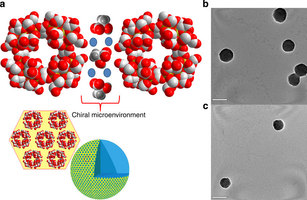
Among the conundrums, the "homochirality" phenomenon upon which amino acids and sugars form is particularly fascinating.
The single-handedness of biological molecules has fascinated scientists since Pasteur first separated the enantiomorphic crystals of a tartrate salt more than 150 years ago because the homochirality of biological molecules is a signature of life.
Now, University of Akron Professor of Polymer Science Tianbo Liu say he has discovered that nature's clear bias toward certain amino acids and sugars and against others isn't accidental. All life molecules are paired as left-handed and right-handed structures. That is chirality. Nature's selection of only right-handed sugars and left-handed amino acids upon which to build life might be much simpler than hypothesized, he says.
Liu found that any molecules, if large enough (several nanometers) and with an electrical charge, will seek their own type with which to form large assemblies. It's "self-recognition" of left-handed and right-handed molecule pairs.

Mechanism for chiral selection. doi:10.1038/ncomms7475
"We show that homochirality, or the manner in which molecules select other like molecules to form larger assemblies, may not be as mysterious as we imagined," Liu says.
While an understanding of how homochirality occured at the onset of life remains a mystery, this new finding emphasizes that Mother Nature's inner workings may not be as complex as we think.
Citation: Panchao Yin, Zhi-Ming Zhang, Hongjin Lv, Tao Li, Fadi Haso, Lang Hu, Baofang Zhang, John Bacsa, Yongge Wei, Yanqing Gao, Yu Hou, Yang-Guang Li, Craig L. Hill, En-Bo Wang, Tianbo Liu, 'Chiral recognition and selection during the self-assembly process of protein-mimic macroanions', Nature Communications 6, Article number: 6475 doi:10.1038/ncomms7475. The research was led by The University of Akron Department of Polymer Science,with collaborators from Northeast Normal University (China), Emory University, Argonne National Laboratory and Tsinghua University. Funded by the National Science Foundation.
Charlton Heston boxing Darwin graphic courtesy of Dr. Michael White, Adaptive Complexity.





Comments